It's a quick, quite rough, painting made with cheap poster paint. And yet, it pointed to something important and its title has been haunting me.
Our flying shapes the sky.
That sentence contains a whole philosophy. The idea of shaping our own sky speaks of the potential power we have in our lives, and of how our thinking constrains us.
The title keeps pushing to be used: for an exhibition, for a project. It remains a title in waiting. And it pervades all that I am trying to do at this point in my life.



























































